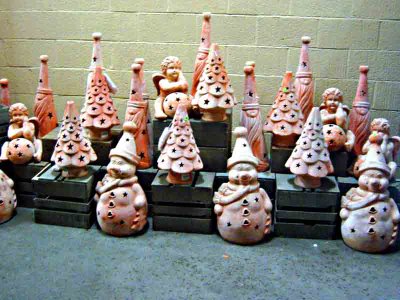The most hallowed Mixed Meters' musical tradition is probably the yearly winter Solstice piece based on Jingle Bells. Theoretically these efforts of seasonal spirit should appear around the "
Holidays". For the last couple of years, however, they have been woefully late.
The previous one,
Solstice Lights, a video composition, was not posted until the summer Solstice, a full half-cycle of calendar behind. Had it been any later, I guess it would have become an early post for this year.
The 2009 Jingle Bells musical composition, entitled
A Combination of Jingle Bells and the Internationale, was posted on May 22, 2010. (That post has links to even earlier Jingle pieces, if you're curious. It also has lots of pictures of Che Guevara.)
This year, for my 2012 New Year's Resolution, I resolved to be more timely about fulfilling this tradition. And so I have. But be warned: I have accomplished this feat by creating a work that is 85% total silence.
It's called
Jingle Bells - The Long Version. It has origins in two different but equally geeky computer issues:
1) For a long time I have been wanting to create some original System Sounds. Those short beeps and zings that a computer uses to say things like "You can't click here" or "There is some sort of a problem." or "You have spam." were really starting to annoy me. The operating system provided few alternative options and those didn't have much variety. I figured a self-styled creative guy like myself ought to be able to make more interesting sounds himself.
2) I upgraded my copy of Sibelius, the program I use to compose music. About a dozen years ago I started with Sibelius 2 and each subsequent version since has been an evolutionary improvement. Much to my surprise, the latest version, Sibelius 7, introduced a completely new structure. Someone, no doubt looking out for my own good, took every single command (of which there are many) and tossed them like a salad. It is like a whole new program, nothing is where I expect it to be. Any long-time user facing the daunting re-learning curve might simply go back to the previous version and never upgrade again.
I sought a way to combine these issues. Could I re-learn this entirely new-but-still-old program by using it to create some original system sounds?
Such sounds need to be exceptionally short. They also must be interesting, complex musical events. I quickly came to think of them as little musical compositions, pieces no longer than two seconds. You'd think these super short works would be an easy task for a guy like me who has already spent lots of time writing short pieces, namely my series entitled
Thirty Second Spots. You'd be wrong - writing a one second piece is a really different ball game.
I gave the idea a go. After creating maybe half a dozen such sounds, some of which have become my regular system sounds, I had another idea. Could I use this new stone to kill yet a third bird - my impending deadline for a Jingle Bells piece for 2011, the one I had resolved to post promptly this year?
And that's how the idea for
Jingle Bells - The Long Version was born.
I would take one chorus and one verse of Jingle Bells, a tune familiar to anyone who lives in a Western, Christmas-dominated culture, divide it into short segments, embellish these segments into rich system-sound-like events and play them in proper order separated by long periods of absolute silence so that, when they do happen, they become interruptions to whatever other sounds might be happening at the moment. In other words, these interruptions would function just the way real system sounds do.
A normal playing of Jingle Bells ought to last less than a minute. I figured that if I stretched that out to six or seven minutes it would seem interminable. I was wrong. I kept making it longer by adding more silence until it was twenty-three and one half minutes long. This makes the melody pretty obscure but you can follow the tune if you concentrate.
It turns out that this 23-minute Jingle piece combines well with other music. I'm someone who often listens to two or even three Internet radio streams at the same time. Adding the system sound interruptions of
Jingle Bells - The Long Version to such a mix often results in excellent musical synchronicity.
In other words, every so often one of the bongs or tweets from my piece blends exactly into the musical moment. This is especially true if the music is in G major or a similar key. I urge you to try it yourself: put
Jingle Bells - The Long Version on continuous play, put on some other music and stay open to what might happen. Baroque music works very well. (Sorry, the online player I'm using doesn't seem to have a continuous play function. I guess you'll have to figure out how to download the mp3 file to try this trick.)
Click here to hear Jingle Bells - The Long Version - © 2011 David Ocker - 1409 seconds.
I pushed the idea one step farther. Once I had completed
Jingle Bells - The Long Version, I imagined shortening it to a short version. Using the Truncate Silence feature of the fine, free audio editor
Audacity, I removed all the silences. The new version is musically identical, except that it only lasts 3 minutes and 32 seconds. That's just 15% of the original. Only the silence has been changed.
I entitled this shortened version
Jingle Bells - The Long Version (Short Version), a name which, after a few drinks, smoothly rolls off the tongue. It's online for you to hear, but the link is elsewhere. You'll have to hunt just a bit. Nothing too difficult.
We at Mixed Meters have become accustomed to observing "
the Holidays" from the viewpoint of non-celebratory outsiders. It was pointed out to me recently that Christmas is the only Christian holiday which is also a U.S. national holiday. As a non-Christian American, I'm pleased that the Christian aspects of Christmas seem to have paled somewhat in recent years.
Meanwhile, December 25 continues to thrive as the high holy day of our real national religion, Capitalism. This is when we Americans are supposed to show our patriotic faith by over consuming. They tell us that all our spending is for our own good. And we believe them. We have faith.
But maybe this year, every American will take 23.5 minutes out of their hectic schedule of spending and eating, giving and taking to listen to my new version of Jingle Bells. The total relaxation time would amount to over 13,000 years. It would be a huge step towards national sanity. What a pipe dream.
Finally - a word about the pictures. Besides the annual Jingle Bells permutation, Mixed Meters has a
Christmas zoology thread. In other words - we investigate which cute animals people use to personify their holidays.
It's commonly known that Christmas has forgone sheep and goats and camels in a manger in favor of reindeer, polar bears, igloos and snowmen. You just have to look around to prove how extensive this shift from "Birth of Jesus" holiday to "Winter Solstice" holiday has become. Even so, a few years ago, I was astonished to see that penguins were becoming regular Christmas animals.
Of course penguins are not mentioned in the bible. What bothered me was seeing them portrayed next to reindeer and polar bears and igloos. Penguins are found in the northern hemisphere only in zoos. Americans are famous for lack of geographical knowledge. I feared that if we saw penguins and polar bears cheek by jowl in "holiday" displays every year, we would start to believe that those animals actually lived together in the wild.
This year I found only a few penguins hanging out with northern hemisphere wildlife in front yards, stores displays and advertisements. But I did find a "Chris-mouse" (thankfully not a "Christ-mouse") and, for the first time ever, two different types of Hannukah bears - some white and some brown, both wearing
yarmulke and
tallis. Needless to say, I am unaware of any bears appearing in the Book of Maccabees, religious or otherwise.
Other penguin-centric Mixed Meters posts you might enjoy:
Stalking the Christmas Penguin
Stalking the Christmas Penguin 2
Christmas Zoology
Christmas in October (which also deals with Halloween and table grapes)
An early Mixed Meters post
In which tomorrow is probably the Solstice
War on Christmas Tags: Jingle Bells. . . system sounds. . . Sibelius 7. . . War on Christmas. . . Christmas penguins. . . hannukah bears. . . hanukkah bears. . . Chanukah bears









































